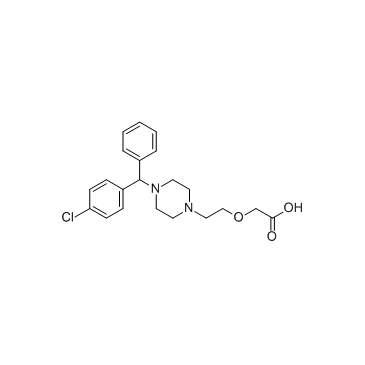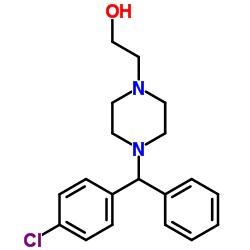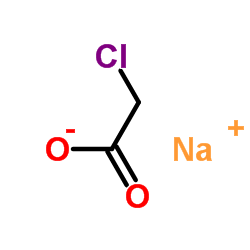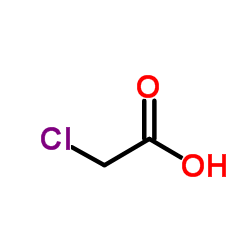Cetirizine

Cetirizine structure
|
Common Name | Cetirizine | ||
|---|---|---|---|---|
| CAS Number | 83881-51-0 | Molecular Weight | 388.888 | |
| Density | 1.2±0.1 g/cm3 | Boiling Point | 542.1±45.0 °C at 760 mmHg | |
| Molecular Formula | C21H25ClN2O3 | Melting Point | 110-115°C | |
| MSDS | N/A | Flash Point | 281.6±28.7 °C | |
Use of CetirizineCetirizine, a second-generation antihistamine, is a major metabolite of hydroxyzine, and a racemic selective H1 receptor inverse agonist used in the treatment of allergies, hay fever, angioedema, and urticaria. IC50 value:Target: Histamine H1 receptorCetirizine crosses the blood-brain barrier only slightly, reducing the sedative side-effect common with older antihistamines. It has also been shown to inhibit eosinophil chemotaxis and LTB4 release. At a dosage of 20 mg, Boone et al. found that it inhibited the expression of VCAM-1 in patients with atopic dermatitis. The levorotary enantiomer of cetirizine, known as levocetirizine, is the more active form. From Wikipedia. |
| Name | cetirizine |
|---|---|
| Synonym | More Synonyms |
| Description | Cetirizine, a second-generation antihistamine, is a major metabolite of hydroxyzine, and a racemic selective H1 receptor inverse agonist used in the treatment of allergies, hay fever, angioedema, and urticaria. IC50 value:Target: Histamine H1 receptorCetirizine crosses the blood-brain barrier only slightly, reducing the sedative side-effect common with older antihistamines. It has also been shown to inhibit eosinophil chemotaxis and LTB4 release. At a dosage of 20 mg, Boone et al. found that it inhibited the expression of VCAM-1 in patients with atopic dermatitis. The levorotary enantiomer of cetirizine, known as levocetirizine, is the more active form. From Wikipedia. |
|---|---|
| Related Catalog | |
| References |
| Density | 1.2±0.1 g/cm3 |
|---|---|
| Boiling Point | 542.1±45.0 °C at 760 mmHg |
| Melting Point | 110-115°C |
| Molecular Formula | C21H25ClN2O3 |
| Molecular Weight | 388.888 |
| Flash Point | 281.6±28.7 °C |
| Exact Mass | 388.155365 |
| PSA | 53.01000 |
| LogP | 2.16 |
| Vapour Pressure | 0.0±1.5 mmHg at 25°C |
| Index of Refraction | 1.589 |
| Storage condition | 2-8℃ |
| Water Solubility | 101 mg/L |
CHEMICAL IDENTIFICATION
HEALTH HAZARD DATAACUTE TOXICITY DATA
|
|
~84% 
Cetirizine CAS#:83881-51-0 |
| Literature: A/S GEA Farmaceutisk Fabrik Patent: EP1157016 B1, 2003 ; Location in patent: Page/Page column 5 ; |
|
~% 
Cetirizine CAS#:83881-51-0 |
| Literature: US2005/20608 A1, ; Page 5 ; |
|
~58% 
Cetirizine CAS#:83881-51-0 |
| Literature: Tao; Yong; Karimian; Khashayar; Tam; Tim Fat Patent: US6046332 A1, 2000 ; |
|
~% 
Cetirizine CAS#:83881-51-0 |
| Literature: WO2004/103982 A1, ; Page 15-16 ; |
|
~% 
Cetirizine CAS#:83881-51-0 |
| Literature: WO2004/103982 A1, ; Page 16 ; |
|
~% 
Cetirizine CAS#:83881-51-0 |
| Literature: US2009/30205 A1, ; Page/Page column 4; 5 ; |
| HS Code | 2933599090 |
|---|---|
| Summary | 2933599090. other compounds containing a pyrimidine ring (whether or not hydrogenated) or piperazine ring in the structure. VAT:17.0%. Tax rebate rate:13.0%. . MFN tariff:6.5%. General tariff:20.0% |
| Acetic acid, (2-(4-((4-chlorophenyl)phenylmethyl)-1-piperazinyl)ethoxy)- |
| (2-{4-[(4-Chlorophenyl)(phenyl)methyl]-1-piperazinyl}ethoxy)acetic acid |
| Reactine |
| CERTIRIZINE 2HCL |
| Zirtek |
| acetic acid, [2-[4-[(4-chlorophenyl)phenylmethyl]-1-piperazinyl]ethoxy]- |
| Cetirizine |
| Ceterizine |
| [(2-{4-[(4-chlorophenyl)(phenyl)methyl]piperazin-1-yl}ethyl)oxy]acetic acid |
| Acetic acid, 2-[2-[4-[(4-chlorophenyl)phenylmethyl]-1-piperazinyl]ethoxy]- |
| vidix |
| P-071 |
| MFCD00800721 |
| (±)-[2-[4-[(4-Chlorophenyl)phenylmethyl]-1-piperazinyl]ethoxy]acetic Acid |
| Cetrizinehydrochloride |
| Formistin |
| (2-{4-[(4-chlorophenyl)(phenyl)methyl]piperazin-1-yl}ethoxy)acetic acid |
| UNII:YO7261ME24 |
| Zyrlex |
| (±)-[2-[4-(p-Chloro-a-phenylbenzyl)-1-piperazinyl]ethoxy]acetic Acid |
![2-{2-[4-[(4-chlorophenyl)phenylmethyl]-1-piperazinyl]ethoxy}acetaldehyde diethylacetal structure](https://image.chemsrc.com/caspic/283/290362-10-6.png)

![2-[2-[4-[(4-chlorophenyl)phenylmethyl]piperazin-1-yl]ethoxy]ethanol hydrochloride structure](https://image.chemsrc.com/caspic/362/1244-76-4.png)



